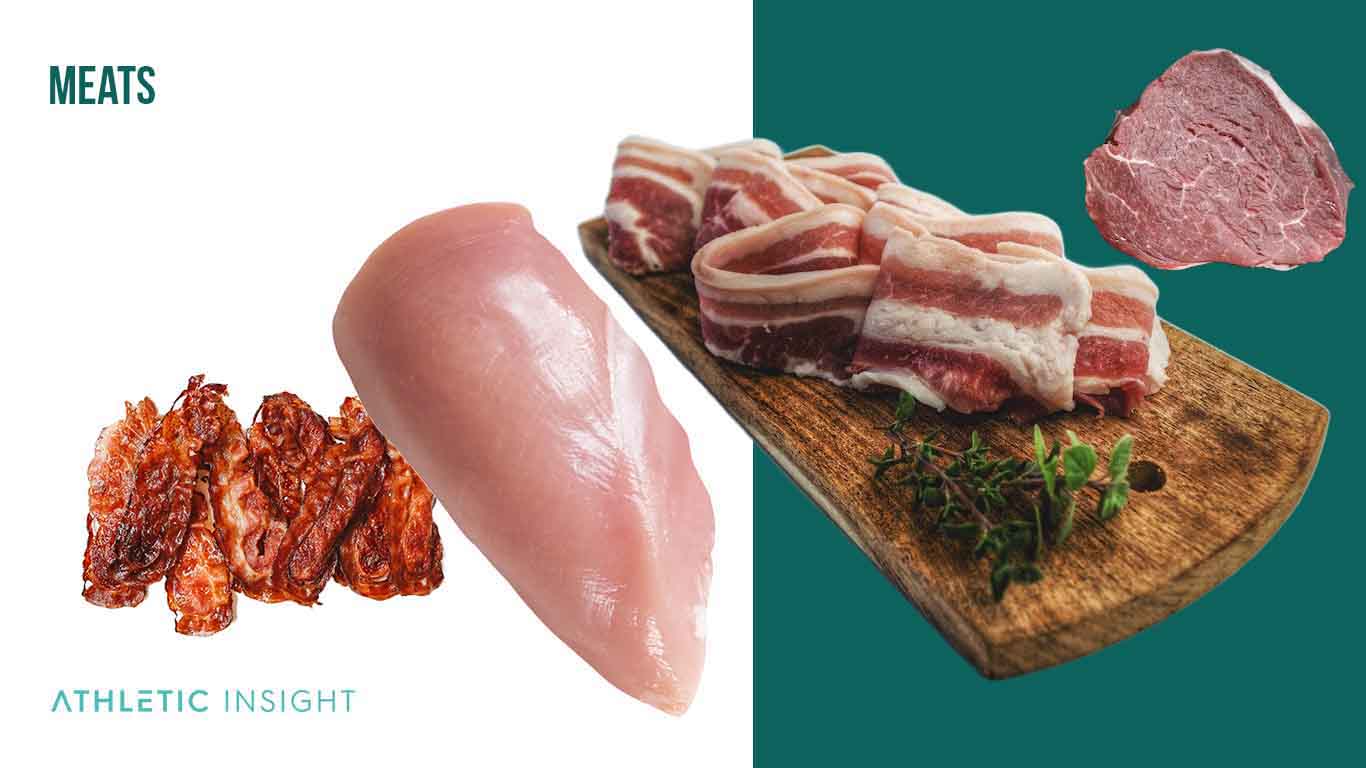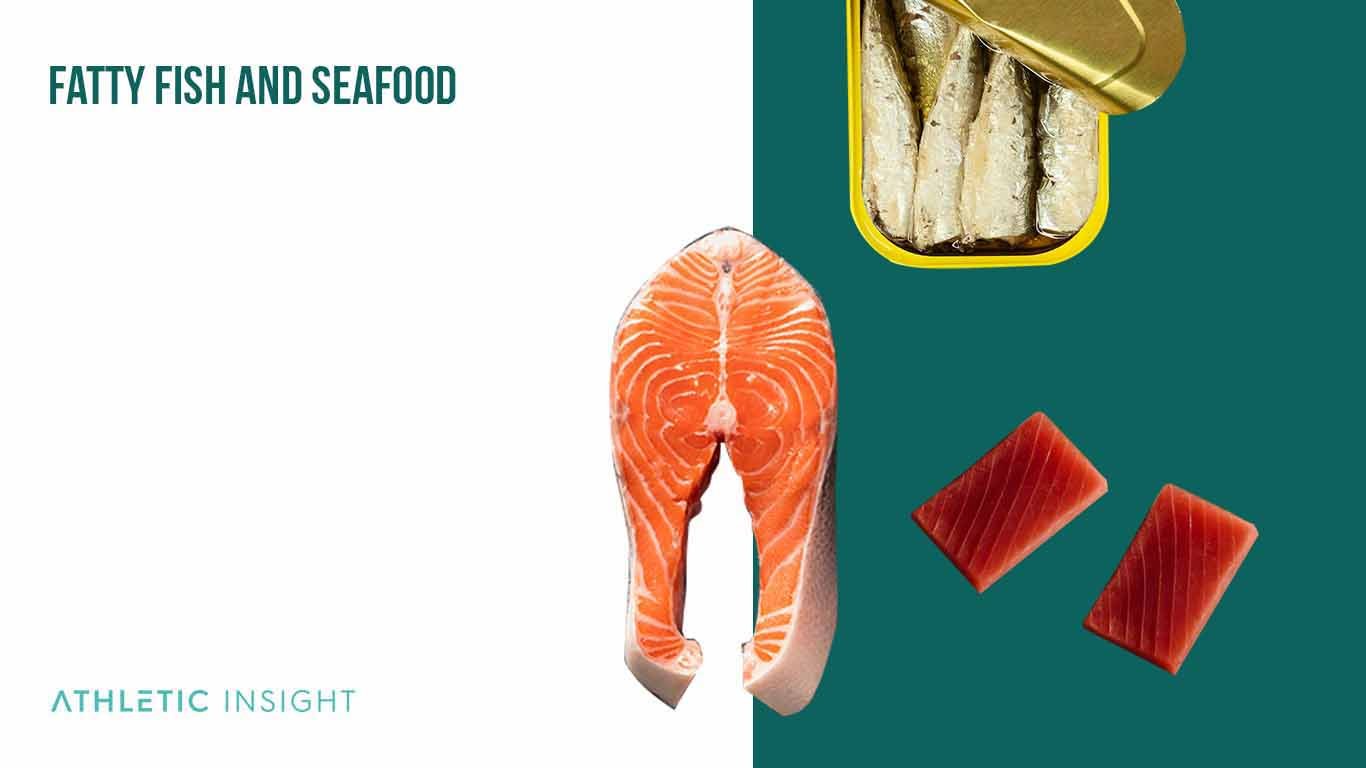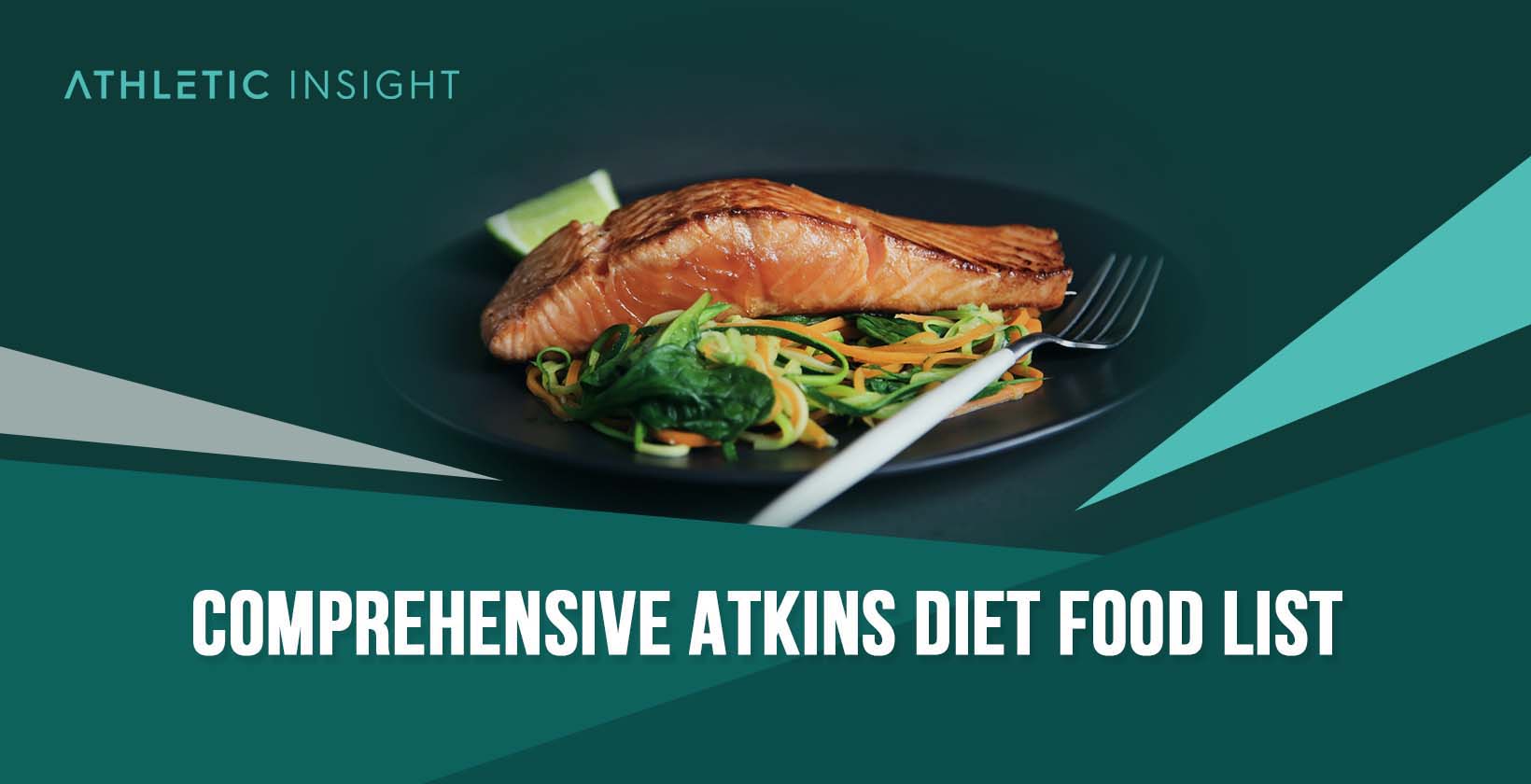The Atkins diet food list involves consuming plenty of lamb meat, chicken, beef, pork, and fatty fish like salmon and sardines. You can also eat eggs and, dairy products like butter, cheese, and yogurt as well as low-carb vegetables like kale and spinach. In this overview, you will learn everything you need to know about the Atkins food list, which starts with foods low in carbohydrates and high in fat and protein.
- Meats
- Fatty Fish and Seafood
- Eggs
- Low-carb Vegetables
- Full-Fat Dairy
- Nuts and Seeds
- Healthy Fats ans Oils
- Beverages
1. Meats
The different types of meats you can consume while on the Atkins diet include bacon, pork, lamb, chicken, and beef.

- Bacon
- Pork
- Lamb
- Chicken
- Beef
The Atkins phase 1 food list is extremely focused on increasing protein intake. Meat products are high in protein and have plenty of health benefits for the typical person. For example, poultry and red meat have protein that is necessary for growth and development as well as essential nutrients like iodine, zinc, iron, and vitamin B12.
The amount of daily meat intake you should have in the typical Atkins diet phase 1 acceptable food list includes about half of a chicken breast in a chicken salad for lunch and about five or six beef or lamb meatballs for dinner.
2. Fatty Fish and Seafood
The Atkins induction food list also includes plenty of fatty fish and delicious seafood. Some of the typical fatty fish you can consume on this diet are as follows.

- Sardines
- Mackerel
- Salmon
- Trout
- Tuna
- Herring
- Whitebait
Essentially, the list of foods you can eat during the Atkins induction phase includes having as much fatty fish intake as you desire. The diet allows you to have as much protein and fat as you desire. The omega-3 fatty acids found in fatty fish provide health benefits like improving cardiovascular health, preventing vision loss, a reduction in breast cancer risk, and protecting against dementia.
3. Eggs
When consuming eggs as part of the modified Atkins diet food list, the best type of eggs to purchase are omega-3 enriched or pastured eggs. These kinds of eggs are the most nutrient-dense ones.

How many eggs should you consume every day? There’s no need to go overboard. You only need to consume two or three eggs in an omelet with butter and fried vegetables on a typical morning. You can also try having bacon and a few sunny side eggs for breakfast.
Your breakfast should continually have eggs and sometimes vegetables fried up in coconut oil or butter. If you’re going to IHOP, you’ll need to bypass those pancakes and order a large omelet instead.
4. Low-Carb Vegetables
Some of the possible low-carbohydrate vegetables that you can have as part of your Atkins diet induction acceptable foods list include the following.
- Spinach
- Broccoli
- Kale
- Asparagus
- Bell peppers
- Mushrooms
- Zucchini
- Avocados
- Cauliflower
- Green beans
To adhere to the Atkins diet, you’ll need to limit the number of carbohydrates you consume each day. As such, low-carb vegetables are a necessity. The Atkins diet requires you to consume less than 150 grams of carbohydrates per day or as low as 20 grams per day.
Many low-carb vegetables have antioxidants that can reduce inflammation and reduce cancer risk. Cruciferous vegetables like kale and broccoli can protect against type 2 diabetes. The Atkins phase 2 food list involves adding low-carb vegetables back into your diet.
5. Full-Fat Dairy
Full-fat dairy products are also an important part of the Dr.Atkins diet food list as it puts a strong focus on protein and fats. The types of full-fat dairy products you can include in your daily meals as part of the Atkins 20 food list are as follows.
- Heavy creams
- Whole milk
- Cheese
- Butter
- Full-fat yogurt
You can consume as much fat in your diet as you like when you follow Akins. For example, you can cook much of your meat and low-carb vegetables in butter every night for dinner. You can also eat a full-fat yogurt with your bacon and eggs for breakfast or as a snack before bed.
Dairy products are healthy since they include calcium to help a human’s skeletal development.
6. Nuts and Seeds
Nuts and seeds are also imperative on the Atkins 14 day induction food list since both are good sources of protein and healthy fats. The typical nuts and seeds that you can eat while on this diet include the following.
- Almonds
- Macadamia nuts
- Walnuts
- Sunflower seeds
- Hazelnuts
These nuts and seeds are part of a healthy Atkins diet, but you should only consume about four ounces of nuts and seeds. Four ounces have approximately 20 grams of net carbs. If you’re trying to keep your carbs low, then nuts and seeds are a fine addition as long as you keep them to four ounces.
These food products can minimize heart attacks and coronary heart disease risks as well as reduce cholesterol levels.
7. Healthy Fats and Oils
Similar to butter, there are plenty of healthy fats and oils that are part of the Atkins diet first phase food list. The types of healthy fats and oils include the following items.
- Avocados
- Avocado oil
- Coconut oil
- Extra virgin olive oil
Consuming high-fat oils found in avocados, for instance, has many health benefits, such as enhancing digestion, reducing cancer risk, and even lowering the risk of depression. Avocados are also a good source of vitamins K, E, C, and B6.
You can use coconut oil or avocado oil to fry up eggs for breakfast, drizzle some in a chicken salad for lunch, or cook up a steak for dinner.
8. Beverages
Beverages are more strict on the Atkins diet than whenever you avoid dieting. There are very few beverages you can consume. These drinks include water, green tea, black tea, herbal tea, and coffee.
Generally, you should choose water as your main beverage when you’re trying to stay healthy and lose weight as part of the Atkins fast food list. When grabbing fast food or ordering restaurant food, don’t forget to choose a steak salad or a chicken salad with a glass of water.
Both coffee and green tea are high in antioxidants, which can help prevent cancer. You can consume any of these acceptable beverages with every meal and snack.
How to Prepare an Atkins Meal Plan?
The sample meal plan for a week on the Atkins diet includes the following.
- Monday: eggs and veggies for breakfast, chicken salad with nuts and olive oil for lunch, and a steak with low-carb vegetables for dinner
- Tuesday: Bacon and eggs for breakfast, grilled chicken and vegetables for lunch, and a bunless cheeseburger with butter and low-carb vegetables for dinner
- Wednesday: eggs and veggies fried in coconut oil for breakfast, ground-beef stirfry with green beans and broccoli for lunch, and salmon with asparagus, bell peppers, and butter for dinner
- Thursday: A tasty omelet with bell peppers and avocados fried in butter for breakfast, shrimp salad with olive oil for lunch, and a ground-turkey stirfry with veggies for dinner
- Friday: Bacon and eggs for breakfast, pork chops with zucchini, broccoli, and green beans for lunch, and grilled chicken wings with veggies and salsa for dinner
- Saturday: A delicious omelet with avocado and numerous veggies fried up in butter for breakfast, ground-turkey meatballs with assorted vegetables for lunch, and a beef steak with asparagus and cauliflower for dinner
- Sunday: Bacon and eggs for breakfast, chicken and kale salad with olive oil and walnuts for lunch, and meatballs with green beans, broccoli, and bell peppers for dinner
How Many Calories Can You Eat While on an Atkins Diet?
There isn’t a specific number for the calories you can eat while on an Atkins diet. However, there is a general range you should take part in. For example, women should try to reach a caloric range between 1,500 to 1,800 calories per day while men should aim for a caloric intake between 1,800 to 2,200 calories per day while on the Atkins diet.
You can still eat whole-wheat bread and pasta while on the Atkins diet as long as it is in very small portions.
How Much Fat Should You Consume Daily on an Atkins Diet?
You can add about three servings of one tablespoon of fats to your daily food intake when on the Atkins diet. The type of fats you can consume include butter, olive oil, avocados, avocado oil, salad dressing, and coconut oil.
You can also consume other high-fat foods like meats, eggs, dairy products, seeds, and nuts. You can also drink up to eight glasses of water per day while on the Atkins diet. You can consume about 60 percent of calories from fat per day on the diet. Some high-fat healthy foods you can eat include cheese, avocados, fatty fish, whole eggs, full-fat yogurt, and nuts.
How Much Protein Should You Consume Daily on an Atkins Diet?
On the Atkins diet, you can consume up to 18 percent of your protein from your daily intake of calories. You should have three to four servings of protein every day with anywhere from four to six ounces of protein per serving.
Some of the best high-protein foods you can include as part of your Atkins 40 approved food list include the following.
- Lean beef
- Eggs
- Chicken
- Peanut Butter
- Salmon
- Lentils
How Many Carbohydrates Should You Consume Daily on an Atkins Diet?
During the induction phase, you need to limit your carbohydrate intake significantly when on the Atkins diet. The Atkins diet phase 1 acceptable food list greatly limits your intake of carbohydrates like loaves of bread, sugar-filled baked goods, fruits, pasta, alcohol, and grains. The induction phase lasts several weeks and requires only 20 grams of carbohydrates per day. You can take it it from high-carb foods.
Essentially, the Atkins phase 1 acceptable food list requires a drop of taking in 45 to 65 percent of your daily carbs from calories to only about 10 percent of daily carbohydrates from your caloric intake. Typical high-carb foods to avoid include rice, bread, pasta, barley, couscous, quinoa, breakfast cereals, crackers, cookies, cakes, and other baked goods.
What Can’t You Eat on an Atkins Diet?
There are specific things you cannot eat on an Atkins 40 food list or the Atkins diet as a whole, which generally involve foods high in carbohydrates. This tends to include pasta and bread as well as fruits. The typical list of the foods you cannot eat on an Atkins diet involves the following foods.
- Sugar
- Grains
- Vegetable oils
- Trans fats
- Diet foods and low-fat foods
- High-carbohydrate vegetables
- High-carbohydrate fruits
- Starches
- Legumes
How is the Food List Expanded According to the Phases of the Atkins Diet?
The first two weeks of the Atkins diet are known as phase 1 or the induction phase, which involves limiting carbohydrates to less than 20 grams per day. This involves eating high-protein and high-fat foods with low-carb vegetables like leafy greens.
The phases of the Atkins diet include phase 2, phase 3, and phase 4 as well. In phase 2, you can add more nuts, low-carb veggies, and a small number of fruits to your diet. Phase 3 involves adding more carbohydrates to your diet to slow down weight loss. The Atkins phase 4 acceptable foods list includes eating as many carbs as you need to without gaining weight.
Is the Atkins Diet Food List Expensive?
Yes, according to the research, it has been shown that the Atkins diet is the most expensive one among seven different popular diets. The most expensive diets include the Atkins diet, the South Beach diet, and a vegan diet. Essentially, the costs of meat products, nuts, seeds, and low-carb vegetables tend to add up with one person on the Atkins diet spending about $100 per week.



